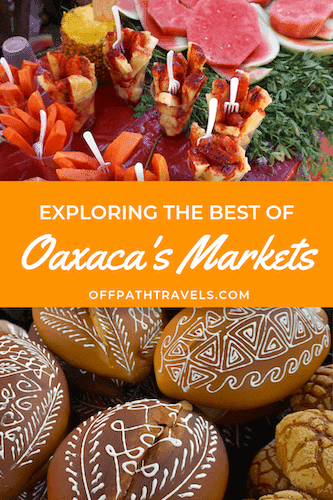Strolling through the best Oaxaca markets, or mercados, is a must when traveling to this magical city in Mexico.
One of the quickest ways to familiarize yourself with a new destination and the local culture is through its markets. And with dozens of unique markets to explore, Oaxaca offers a variety of opportunities for a deep dive into its fascinating world.
From the colorful embroidered shirts at Mercado Benito Juárez to the mouthwatering street food at Mercado 20 de Noviembre, these markets are a glimpse into authentic Oaxaca.
We’ve lived in Oaxaca for months, and exploring, eating, and shopping at the local markets is one of our favorite things to do here. We’re sharing the most popular markets, plus a few lesser-known gems you won’t find anywhere else online.
Ready to wander the best Oaxaca markets? Join me (your Mexican travel guide) as we explore 20 of the best markets in Oaxaca City and the surrounding villages, along with the highlights and must-try foods.
¡Vámonos a los mercados de Oaxaca!
We link to products and services we think are useful for our readers. We may earn a commission for purchases made through some of these links. There’s no extra cost for you and it helps support our work. We really appreciate your support!
Best Oaxaca Market Tours
You can wander the markets on your own, but booking an Oaxaca markets tour with a knowledgeable local guide is the best way to fully immerse yourself in the experience and gain important insight into the Oaxacan culture.
Here are our top 3 picks for the best Oaxaca market tours:
- 🌮 Best Food & Markets Tour: Eat Like a Local Oaxaca Food Tour
- 🧑🍳 Best Cooking Class & Market Tour: Oaxacan Cooking Class and Market Visit
- 🌶 Best Village Market Day Tour: Tlacolula Sunday Market with Local Guide
About the Markets in Oaxaca, Mexico
The markets in Oaxaca, or mercados in Spanish, are an integral part of the culinary and cultural landscape of Oaxaca City and the wider Oaxaca region. These vibrant marketplaces offer a wide array of Oaxacan food, local produce, and artisanal crafts that showcase the unique flavors and traditions of the area.
The history of markets in Mexico dates back to pre-Hispanic times when indigenous civilizations established vital trading networks. These markets were crucial for the exchange of goods, including agricultural produce, textiles, crafts, and other commodities.
Oaxaca City itself is home to a variety of markets, including the famous Mercado Benito Juárez and Mercado 20 de Noviembre. These bustling Oaxaca markets are renowned for their diverse offerings, ranging from fresh fruits, vegetables, and spices to mouthwatering street food delicacies. Travelers can savor authentic Oaxacan dishes like tlayudas, mole, and quesillo while exploring the bustling aisles of these markets.
Beyond Oaxaca City, the towns and villages surrounding the region also host vibrant street markets, known as dia de plaza or tianguis. These village market days provide a unique opportunity to experience the authentic essence of Oaxaca, where local communities come together to showcase their agricultural products, crafts, and traditional cuisine.
Día de plaza refers to the specific market day in a particular town or village. It is a day when the market comes alive, bustling with activity as vendors set up their stalls and locals gather to buy and sell goods. Tianguis, on the other hand, refers to open-air street markets or temporary marketplaces where vendors set up their stalls or blankets to sell their products, similar to flea markets.
Exploring the Oaxaca mercados and street markets is a sensory delight. Visitors can indulge in tantalizing street food, from freshly prepared tamales and empanadas to crispy chapulines (roasted grasshoppers) and refreshing aguas frescas (fruit-based beverages). The markets also offer an abundance of artisanal crafts, including intricate textiles, pottery, and hand-carved wooden sculptures, allowing visitors to take a piece of Oaxaca’s vibrant culture home with them.
Whether you’re wandering through the colorful aisles of Mercado Benito Juárez in Oaxaca City or immersing yourself in the lively atmosphere of village market day in Tlacolula, the Oaxaca markets are a must-visit for any traveler seeking to explore the diverse flavors, rich traditions, and vibrant street food culture that define this enchanting region.
Oaxaca Markets Map
With so many markets in Oaxaca, it can be difficult to figure out where each one is. We created this Oaxaca markets map to help you find your way around.
Best Oaxaca Markets to Visit
From fresh produce to traditional crafts, the best markets in Oaxaca offer a captivating blend of Oaxacan heritage and local products.
The list below includes the most-visited Oaxaca City markets, lesser-known local markets, and the best market days in the villages near Oaxaca.
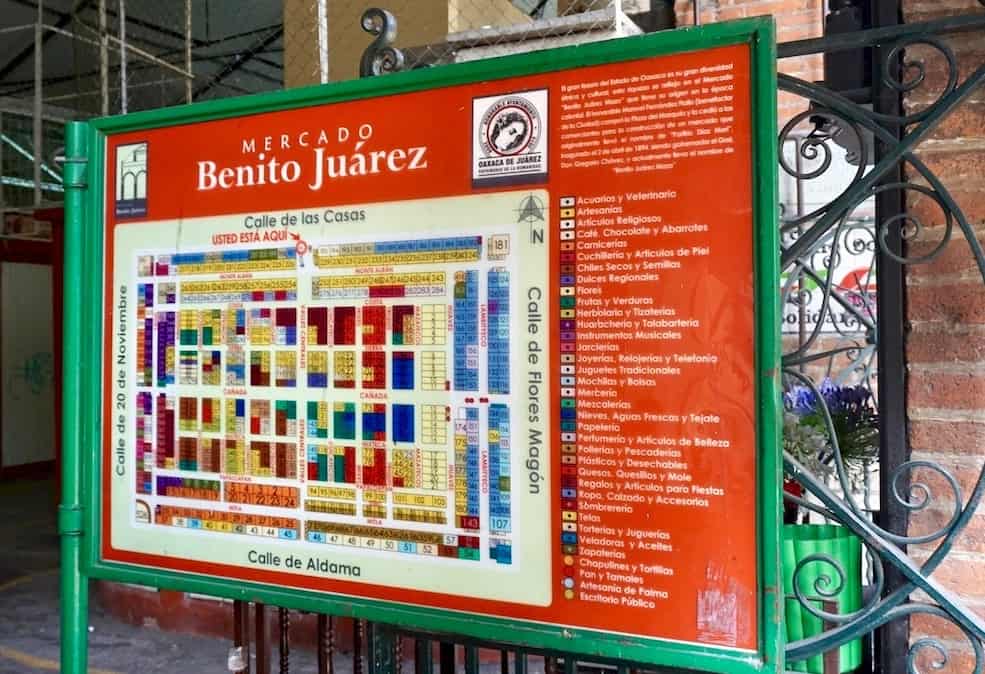
1. Mercado Benito Juarez
View Benito Juarez Market Location
For a one-stop Oaxaca City market with a bit of everything, look no further than Mercado Benito Juárez.
Mercado Benito Juarez in Oaxaca is named after Mexico’s first indigenous president and esteemed Oaxaca native, Benito Juárez.
Located a few blocks south of El Zocalo (main square), Benito Juarez Market is one of the city’s most popular indoor markets and a must-visit destination for mercado lovers.
From handmade huaraches (leather sandals) to crunchy chapulines (dried grasshoppers), its dizzying variety of colors, flavors, and fragrances fills up an entire city block in the heart of Oaxaca.
The northern side of the market is home to rows of colorful traditional embroidered dresses, shirts, and other locally-made clothing and textiles. If you’re clothes shopping in Oaxaca, this is the best place to buy a wearable souvenir!
As you walk south, you’ll stumble upon the food section with rows of stands selling everything from tortas (sandwiches) to hand-made ice cream.
If you don’t know much about Oaxacan food, you’re in for a delicious surprise! We love it so much that we wrote an entire article with all of the top foods and drinks to try in Oaxaca.
We’ve had incredible snacks here: fresh squeezed papaya and orange juices and empanadas being our go-to items.
Don’t pass up the aguas frescas (locally known as aguas de sabores)! These are juice-like drinks which come in more flavors than you can imagine and are made with fruit, flowers, cereals, or seeds.
Stop by the historic Aguas Casilda for an authentic agua fresca. This popular spot has served up its famous horchata de almendra con tuna for decades. It’s plant-based rice and almond milk with a splash of pink tuna (prickly pear) juice served with cubes of cantaloupe and topped with nuts.
In the mood for dessert? Try the regional ice cream flavor, leche quemada (burnt milk), at Nieves Oaxaqueñas Chagüita.
For something truly traditional, look for the women using their entire forearms to stir a chocolatey-brown liquid in giant clay bowls at La Flor de Huayapam. They are preparing tejate, a popular prehispanic drink once sipped by Zapotecs and an Oaxacan favorite throughout the centuries. This frothy, corn-based beverage is made with cacao, mamey seeds, and florecita de cacao.
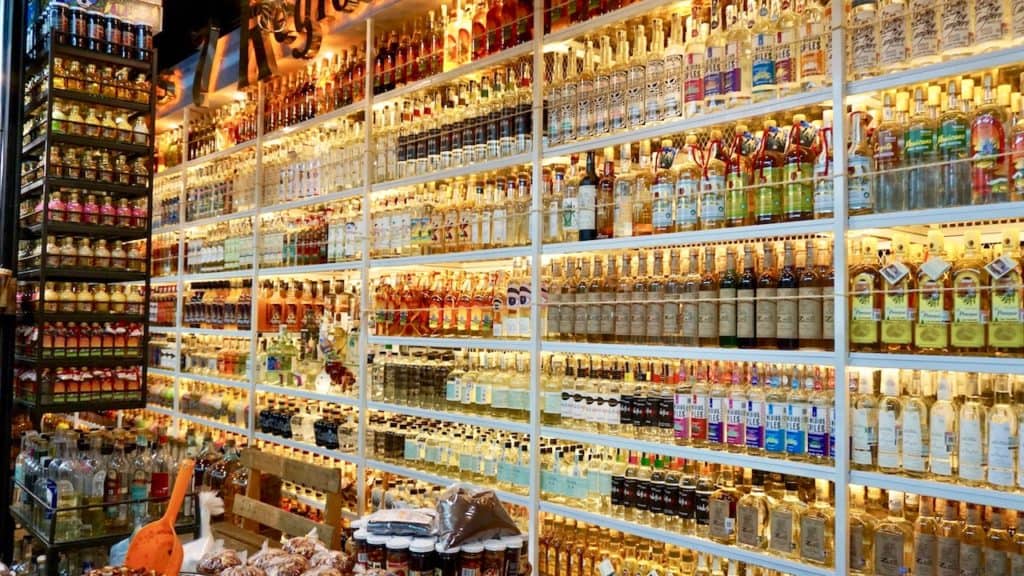
And since you’re in Oaxaca, the mezcal (locally made agave liquor) shops are all around. Most of them will gladly fill up a tiny shot glass for you to try a taste.
🥃 Learn more about Oaxaca’s favorite drink on this hands-on mezcal distillery tour where you participate in nearly all stages of traditional mezcal production.
On the south side of the Benito Juárez Market, you’ll find rows of butchered meats, fresh quesillo (Oaxaca cheese), and whole chickens for sale.
Take the narrow hallway leading to the southern exit for a taste of a true Oaxacan delicacy, dried chapulines (grasshoppers). Chapulines are a common crunchy snack in Oaxaca and a must-try for visitors.
Scooped out of large bins and sold in small bags, chapulines range from larger grasshoppers about 1.5 inches long down to little guys less that are than a half inch. Nearly every Oaxacan restaurant has them featured somewhere on the menu.
Vendors sell them by the bag in a variety of flavors: plain, salted, lime and salt, and spicy. These stands also sell other popular insect products like sal de gusano de maguey (agave worm salt) and the seasonal hormigas chicatanas (flying ants). Oaxacans are truly ahead of the times since eating insects is a great way to reduce our impact on the environment.
Once you step outside the market, you’ll stumble upon a sidewalk full of stall after stall selling freshly-picked tomatoes, avocados, onions, chiles, herbs, squash blossoms, and local fruits.
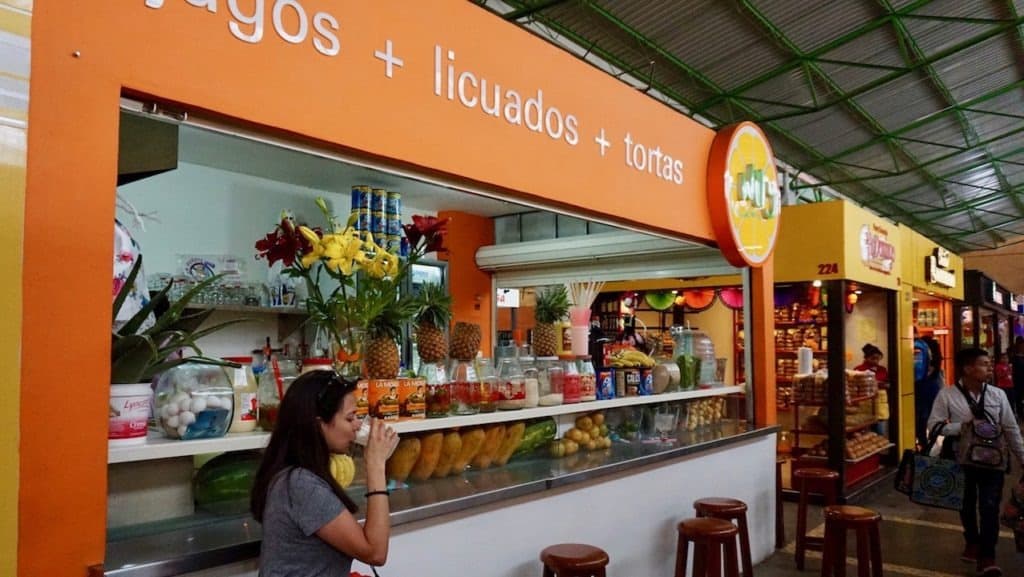
2. Mercado 20 de Noviembre
View Mercado 20 de Noviembre Location
Mercado 20 de Noviembre, or November 20th Market, is situated directly across the street south of Benito Juarez Market in Oaxaca City. The mercado is named after the day the Mexican revolution began in 1910, also a national holiday.
Known for its smoke-filled pasillo de humo (meat hall) and inexpensive eateries, 20 de Noviembre is considered the best food market in Oaxaca. It’s the perfect place to savor delicious and inexpensive street food in Oaxaca.
Here you’ll find juice and torta stands, vendors selling Oaxaca’s seven moles and chocolates, and endless rows of freshly baked regional bread, like pan de yema and pan de cazuela.
🫔 Want to taste Oaxaca’s seven moles? Book this mole and mezcal tasting led by a professional sommelier.
The northern entrance greets you with a colorful juice stand where you can grab freshly-pressed green juice with nopal (prickly pear cactus).
Upon entering the market, you see about eight different soup vendors selling menudo, a traditional Mexican soup made with tripe and a well-known hangover cure.
Next, you come across the bread section with a variety of freshly baked bread in all shapes and sizes, like the usual pan dulce (sweet bread) and the local favorite, pan de yema (yolk bread). Pan de yema is slightly sweet, but not as sugary as most pan dulce.
If you’re visiting around the Day of the Dead in Oaxaca, make sure to buy a seasonal pan de muertos, or bread of the dead.
For a typical Oaxacan breakfast, head to Comedor Tipico La Abuelita and order a traditional chocolate con agua (water-based hot chocolate) and a pan de yema to soak it up.
The comedores area on the eastern side has about 30 different vendors serving Oaxacan classics like tlayudas, enfrijoladas, and mole con pollo.
These aren’t street food stands and many have been here for generations. They are small, family-owned eateries with tables where you can sit and enjoy your meal.
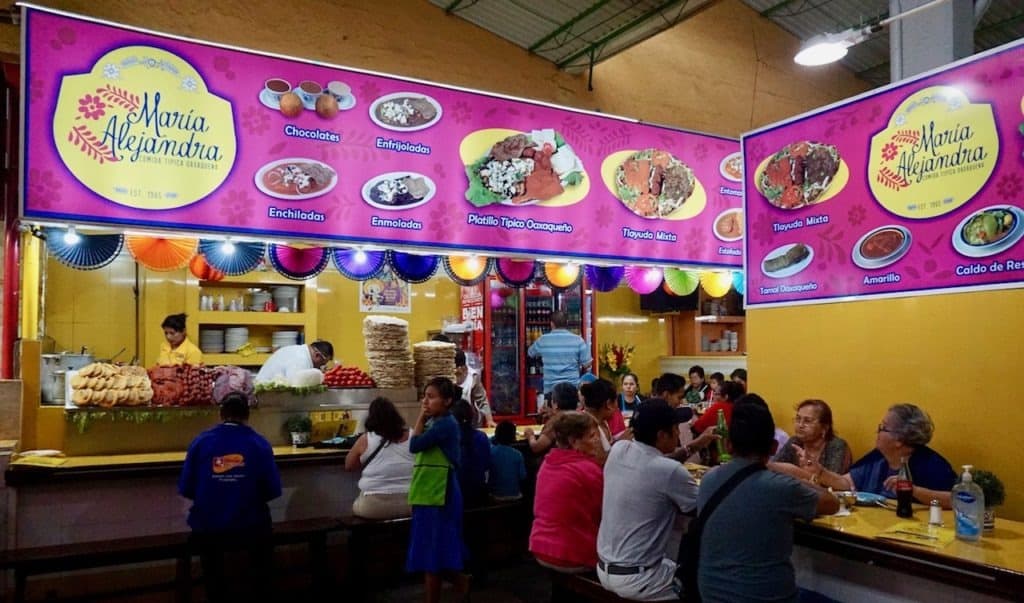
Our favorite comedor at 20 de Noviembre is Maria Alejandra. Order a platillo tipico Oaxaqueño for a sample platter of traditional Oaxacan flavors or a delicious vegetarian tlayuda topped with flor de calabaza (squash blossom) and strips of grilled cactus.
Tlayudas (tlah-yoo-das) are a pizza-like dish native to Oaxaca. A large, toasted tortilla serves as the base, covered with a light layer of black bean paste and aciento (pork fat). On top goes quesillo (stringy Oaxacan cheese), sliced tomato, lettuce or cabbage, and whatever other toppings you want: mushrooms, squash flower, sausage, chicken, marinated beef, tripe, etc.
Be sure to try the traditional mole negro which Oaxaca is known for, a complex sauce made from chiles, chocolate, and dozens of other ingredients.
Wash it all down with a smoky mezcal or a refreshing michelada, a beer cocktail somewhat similar to a bloody mary.
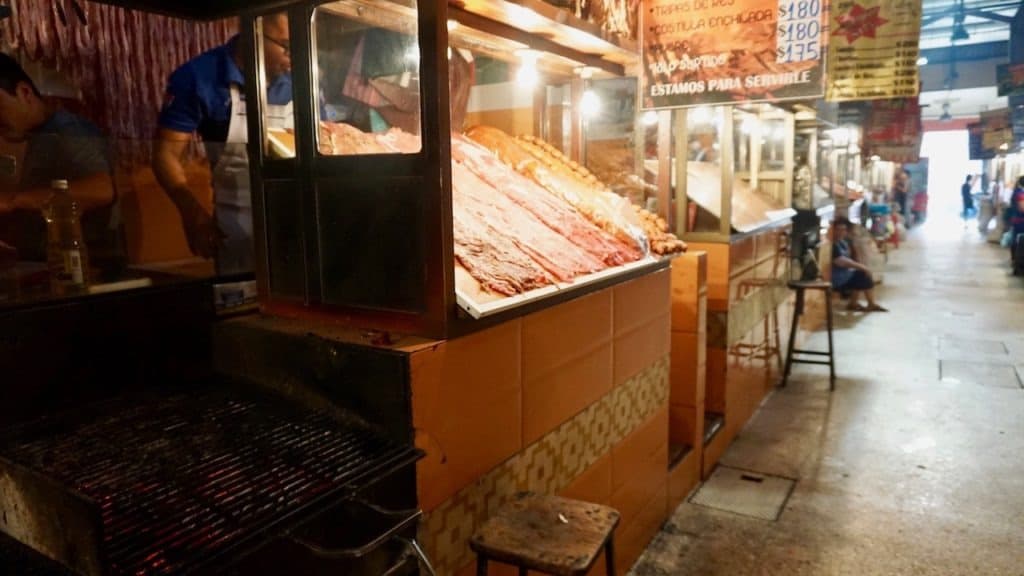
Pasillo de Humo (Meat Hall)
Nestled amongst the row of restaurants along the eastern wall lies the archway to the famous smoke-filled meat market, or pasillo de humo. As you walk down the hazy hallway, you are flanked by vendors selling piles of thinly-sliced meats surrounded by hanging sausages.
Between the vendors are red-hot wood-fire grills where they prepare your order. The rich smoke of meat cooking over coals is visible in the air and you can locate the market anywhere in the city by spotting the plume of smoke rising in the sky.
The specialties here include tasajo (beef) and chorizo Oaxaqueño (Oaxacan sausage). Once your meat is ready, find a seat at a nearby table and order some tortillas, grilled onions, salsas, and avocado to complete the meal.
🌮 Need help ordering? Eat like a local on this authentic Oaxacan food tour where you get to sample over 20 foods at these markets with a local guide, including a visit to the famous 20 de Noviembre meat hall.
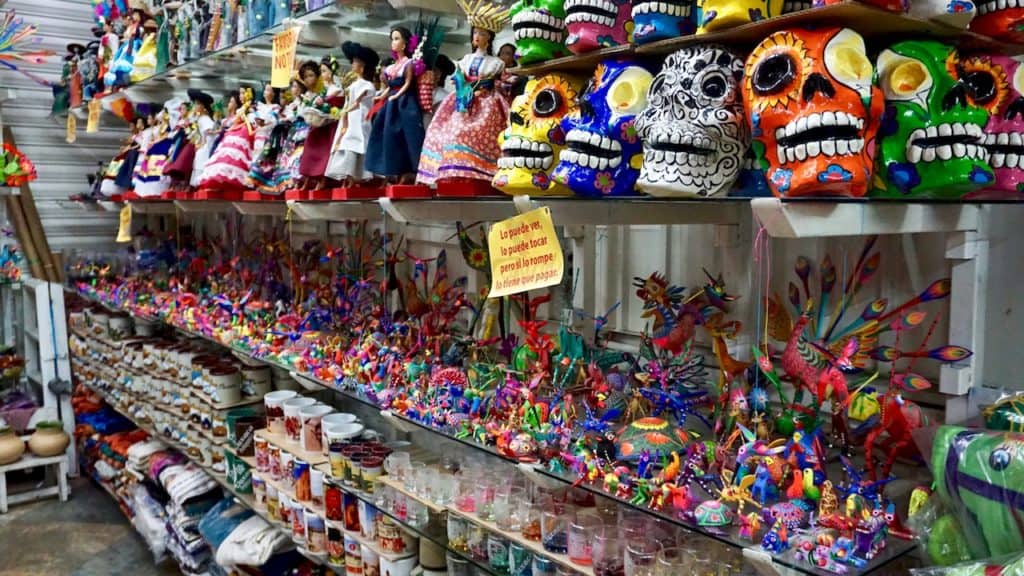
3. Oaxaca Artisan Market
Shopping for local handicrafts? Head to the Mercado de Artesanias de Oaxaca, or Oaxaca Artisan Market, located just one block southwest of 20 de Noviembre Market.
A haven for art enthusiasts, Mercado de Artesanías showcases the incredible talent of Oaxaca’s skilled artisans from surrounding villages. Wander through the market and admire the vibrant colors and intricate designs of the textiles on display.
From beautiful woven Oaxaca rugs to intricately embroidered clothing and handbags, there’s a piece of Oaxacan craftsmanship to suit every taste.
The market is also a treasure trove for pottery lovers, featuring a variety of clay vessels, from traditional cooking pots to decorative plates and bowls adorned with intricate patterns. Traditional Oaxacan pottery comes in three different colors: barro negro (black clay), barro verde (green clay), and barro rojo (red clay).
Wooden carvings are another highlight, with skilled artisans creating exquisite alebrijes. Oaxaca’s famous alebrije wooden carvings are intricate; many are no larger than your fist, but full of detail, often depicting an animal-like creature, and painted in an array of vivid colors.
🎨 Visit the artisan village where alebrijes are made and create your own on this 5-star Paint Your Alebrije Tour.
Whether you’re searching for a unique home decor item or a one-of-a-kind souvenir, Mercado de Artesanías offers a wide range of authentic and artfully crafted pieces that embody the rich cultural heritage of Oaxaca.
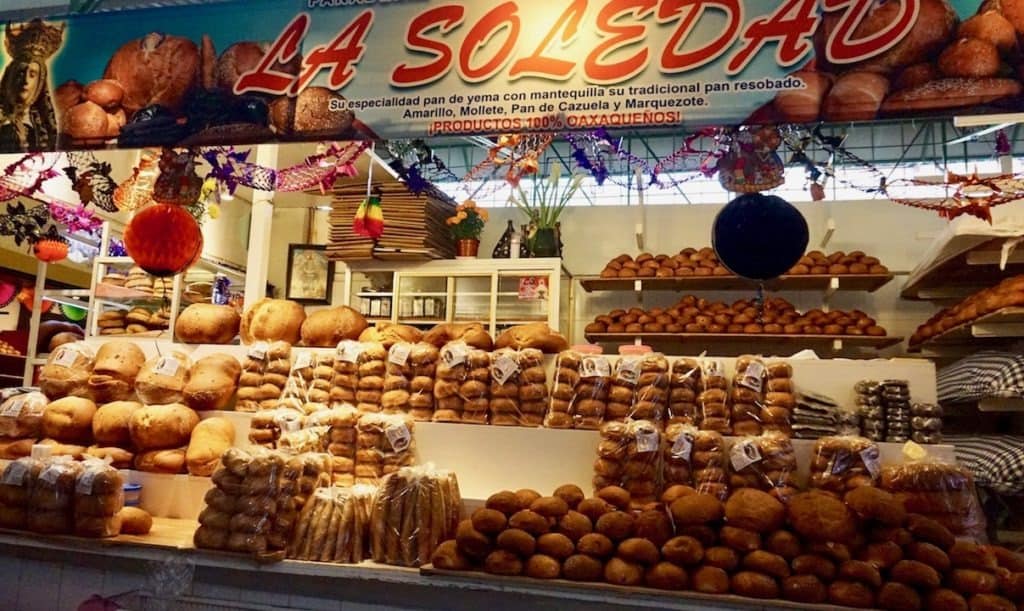
4. Mercado Central de Abastos
Also known as Central de Abasto Oaxaca, and officially named Mercado Margarita Maza de Juárez, this is the biggest market in Oaxaca and a true feast for the senses. This sprawling traditional market is a labyrinth of vendors covering several blocks west of the city center.
Central de Abasto is known for its low prices and an incredible variety of goods, from seasonal produce to pirated movies to wooden furniture.
There is an endless array of fresh fruits and vegetables, aromatic herbs, dried chiles, and local spices for sale here. This is where vendors from Oaxaca’s smaller markets and chefs from the city’s top restaurants come to shop.
Explore the sections dedicated to regional specialties, such as aromatic Oaxacan chocolate, renowned for its rich and complex flavors. Be sure to browse the stalls offering fresh cheese, including the famous quesillo, as well as a wide selection of meats and seafood.
🍫 Make your own Oaxacan chocolate bar at this Traditional Oaxacan Chocolate Class.
Arrive early to wander the maze of vendors and take in the incredible amount of things for sale at Oaxaca’s largest market.
Once you work up an appetite, grab a seat at one of the most famous food stalls in Oaxaca: Memelas Doña Vale. Known for her hand-made memelas topped with a deliciously spicy morita salsa and cooked on a wood-fired comal, this food stand is featured in multiple Netflix shows and countless YouTube videos. Memelas are thick corn tortillas with a slightly raised edge. They are topped with aciento, black bean paste, cheese, meat, and, of course, an overflowing spoonful or two of fresh salsa.
To get a real sense of exactly how much of a crucial hub this market is, visit on Saturday. That’s the day when vendors from around the state travel to sell their wares at Central de Abastos, one of the largest markets in the country.
🚨 Several Oaxaqueños warned us to leave our valuables behind and avoid wearing anything expensive-looking when visiting Abastos Market due to the risk of pickpockets. Stash extra cash in a hidden spot using this belt with hidden money pocket or this secret bra pouch. To be completely safe, we also use an anti-theft bag with slash-proof fabric.
5. Mercado de La Merced
A popular stop on street food tours, Mercado de La Merced, or La Merced Market, is a small, yet lively, indoor market just south of Oaxaca’s colorful Jalatlaco area.
It’s a typical neighborhood market where locals shop for their groceries and come to enjoy an authentic meal. La Merced Market sells fresh fruits and vegetables, meats and poultry, cheeses, bread, tamales, and more.
🧑🍳 Want to learn about the local ingredients? Take this highly-rated Oaxacan cooking class with market tour where you visit a market, learn about the ingredients, and prepare your own delicious meal.
One of the highlights of this market is its cozy comedor area with several delicious eateries with traditional barbacoa (barbeque) served on weekends.
The most popular comedor is Fonda Florecita, located right next to the wall covered with signatures. You can try a variety of authentic Oaxacan antojitos here, including corn tamales wrapped in banana leaves and enfrijoladas (tortillas smothered in a black bean sauce).
A must-try drink is the hard-to-find Oaxacan-style chocolate atole, not to be confused with regular Mexican atole made with chocolate. This hot, corn-based beverage takes days to prepare and is usually reserved for special occasions like weddings. It’s prepared with cacao, fermented balam beans, rice, and wheat berries, with a chocolate foam topper.
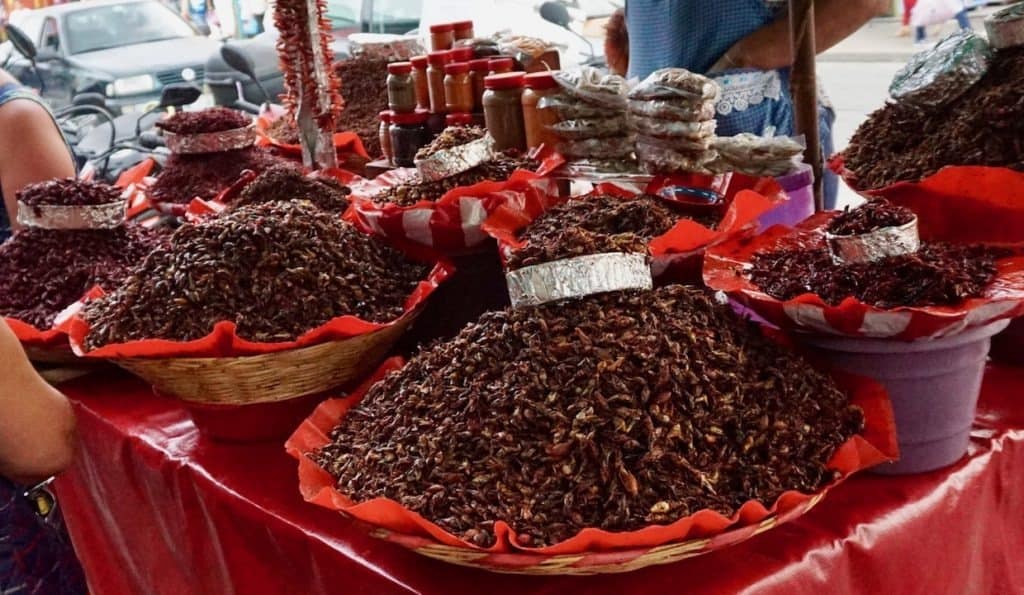
6. Mercado Sánchez Pascuas
View Sanchez Pascuas Market Location
Mercado Sanchez Pascuas, or Sanchez Pascuas Market, is a vibrant neighborhood market situated a few blocks northwest of the iconic Santo Domingo Church.
It’s a small, slow-paced market filled with locals, and it’s not nearly as crowded as the more touristy markets south of Zocalo, like Benito Juarez and 20 de Noviembre.
Sanchez Pascuas Market focuses mostly on food and eateries. You won’t find many handicrafts or souvenirs here.
This is our favorite place to buy seasonal local fruits and vegetables, like freshly harvested flor de calabaza, nopales, and huitlacoche, a delicious corn fungus also known as Mexican truffle.
Stop by the line of ladies selling a variety of handmade salsas and masa-based products, such as blandas, tlayudas, and memelas, to pick up some items to prepare at your accommodations.
Our go-to green juice stand, Super Jugos Angelitas, sits right across from the row of salsa vendors. The walls of this popular juice and sandwich stand are plastered with endless combinations of fruit and vegetable juices to try.
7. La Cosecha Organic Market
This Oaxaca organic market is hidden behind a colorful facade in a colonial building in front of the tranquil Jardin Carbajal.
Founded in 2016, Mercado Organico La Cosecha, or La Cosecha Organic Market, is a charming, shaded courtyard dotted with picnic tables and surrounded by vendors. It’s a beautiful outdoor food court that’s popular with tourists and locals looking for healthy, sustainable, and organic foods and handicrafts.
Vegans and vegetarians flock to this small market to try plant-based versions of traditional Oaxacan dishes. The eateries here are familiar with dietary restrictions and will happily accommodate most of them.
Some of the must-try vegan items are the tamales de amarillo (tamales filled with yellow mole and mushrooms), memelas topped with grilled veggies, and empanadas (large corn tortillas) stuffed with squash blossoms.
🌱 Take this Vegan and Vegetarian Oaxacan Cooking Class to visit a local market and learn how to prepare your own traditional Oaxacan dishes.
There are several traditional beverages for sale here, including tejate served in traditional hand-painted jicaras (dried gourds), aguas frescas, and pulque (a prehispanic fermented agave drink).
This tiny market also sells organic produce and herbs, coffee, pastries, and natural beauty products.

8. Mercado Hidalgo
Mercado Hidalgo, or Hidalgo Market, is located in Colonia Reforma, an upscale neighborhood north of the city center.
Hidalgo market is a small neighborhood mercado known for its cleanliness, but also for its slightly higher prices. Here you’ll find rows of vendors selling beautifully arranged baskets of seasonal fruits and vegetables (including specialty produce), local cheese, meat and poultry, and fresh-baked bread.
There’s also a nice food court with a grill in the center where they prepare grilled meats on the weekends.
For some of the best local dairy products in town, check out Lacteos Arce on the exterior side of the market. Try their quesillo (Oaxacan string cheese), queso (fresh cheese), and housemade mantequilla (butter) sold by the bag.
9. Mercado IV Centenario
View Centenario Market Location
For an even more locals-only market, head a few blocks northwest from the Zocalo to Mercado IV Centenario, or Centenario Market. The prices here are typically lower than the more popular markets above and you won’t see any street food walking tours here.
Mercado Centenario is a smaller neighborhood market with a row of restaurants on the outside on the eastern side, a line of juice stands and breakfast spots near the northern end, produce along the west side, and meats and cheeses to the south. Arrive early for a chance at buying the fresh-baked bread in the center.
Stop by Las Quecas de Oaxaca for deep-fried quesadillas stuffed with the filling of your choice and topped with shredded lettuce and cheese.
Budget-conscious travelers can enjoy a filling breakfast for just a few pesos at one of the restaurants lining the market’s exterior wall. Order delicious entomatadas (tortillas smothered in a tomato sauce) and freshly squeezed orange juice.
🍨 Craving something sweet? Walk half a block east to enjoy an authentic nieve oaxaqueña, or Oaxacan ice cream, at the tree-shaded Plaza de la Danza in front of the Nuestra Señora de la Soledad Church.
10. El Pochote Rayon Organic Market
El Pochote Rayon, or Pochote Rayon Market, is a food court with healthy food options and natural products set in a modern building. It’s located a short walk southeast of Zocalo, just north of Barrio La Noria.
A favorite amongst those looking for a cheap meal and vegetarian options, this market functions more like a restaurant with plenty of outdoor tables at the center. Grab a fresh jugo verde (green juice) or smoothie from Señora Mora and enjoy a cheap meal in the courtyard.
11. El Pochote Reforma Organic Market
El Pochote Reforma is located north of the city center in Colonia Reforma. It calls itself a mercado agroecologico y cultural, or agroecological and cultural market.
This outdoor market features communal tables covered by a large shade structure and surrounded by trees and shops.
Pochote Reforma focuses on locally-made natural products, organic produce, healthy dishes, and sustainable living. There are over 15 vendors selling everything from textiles to goat cheese to pottery.
It’s a pleasant and relaxed atmosphere where you can enjoy a healthy meal with live music on the weekends. They also host cultural events and educational workshops.
12. Santo Domingo Handicraft Tianguis
View Santo Domingo Tianguis Location
Located along the southern side of the Santo Domingo Temple, this tianguis sells arts and crafts from across Mexico.
It’s not much more than a row of canopy tents in Jardin Gurrion, but it’s a centrally-located spot to buy anything from scorpion-encrusted souvenirs to knit wool sweaters from Chiapas.
13. Tianguis Cultural Libertad y Resistencia
View Cultural Tianguis Location
Tianguis Cultural Libertad y Resistencia, or Cultural Liberty and Resistance Market, is a collection of stalls along Plazuela del Carmen Alto in Oaxaca Centro.
This interesting activist market sells jewelry, graphic t-shirts, books, incense, and more.
14. Jardin Labastida Weekend Art Walk
This art and jewelry market takes place on the weekends in Jardin Labastida, or Labastida Garden. It’s more of a park with trees and a fountain than a true garden and it’s situated conveniently along Oaxaca’s popular pedestrian walkway, Andador Macedonio Alcala.
Artists line up on the weekends here to exhibit and sell their work. This is a great spot to buy stunning pieces of art directly from the local Oaxacan artists.
Food vendors and musicians also come by to feed and entertain the market-goers.
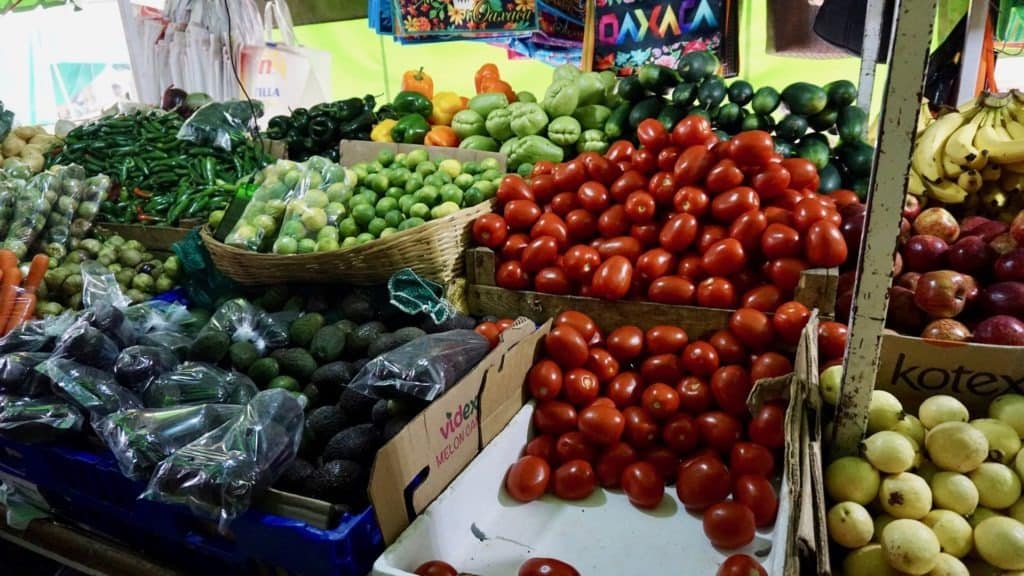
15. Oaxaca City Neighborhood Tianguis
Tianguis are weekly flea markets that are temporarily set up in neighborhoods throughout Mexico, including the City of Oaxaca.
These types of pop-up markets take place every week on a specific day. Here are the tianguis days for some of the most popular neighborhoods for tourists:
- Colonia Reforma Tianguis – Tuesdays
- Jalatlaco Tianguis – Fridays
- San Felipe del Agua Tianguis – Tuesdays, Fridays, and Saturdays
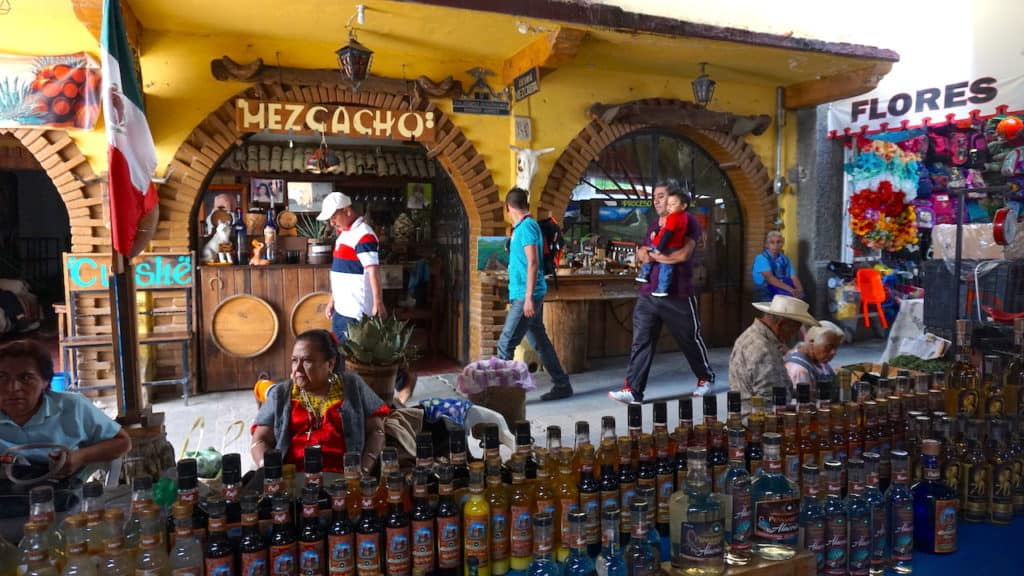
Oaxaca Market Days
In the towns surrounding Oaxaca City, village market days are weekly events that provide a glimpse into the rich cultural heritage and traditions of the region. These market days are an integral part of communities, where Oaxaqueños travel from far and wide to come together to buy, sell, and socialize.
On dias de plaza, or market days, the town’s quiet central plaza transforms into a bustling hub of activity. Local farmers, artisans, and vendors set up their stalls, offering a wide range of fresh produce, handmade crafts, traditional textiles, farming tools, and home goods.
Skilled artisans showcase their talents, displaying handwoven textiles, intricately carved wooden sculptures, pottery, and jewelry. These crafts are often rooted in ancient techniques passed down through generations in indigenous communities.
Dias de plaza are not just about shopping; they are also social occasions where locals and visitors come together, sharing stories, laughter, and traditional foods and drinks.
Attending a village market day, like Tlacolula and Ocotlan, as a tourist provides a unique opportunity to immerse oneself in the authentic spirit of rural Oaxaca. It’s a chance to witness the interplay of tradition, commerce, and community that has sustained these indigenous towns for centuries.
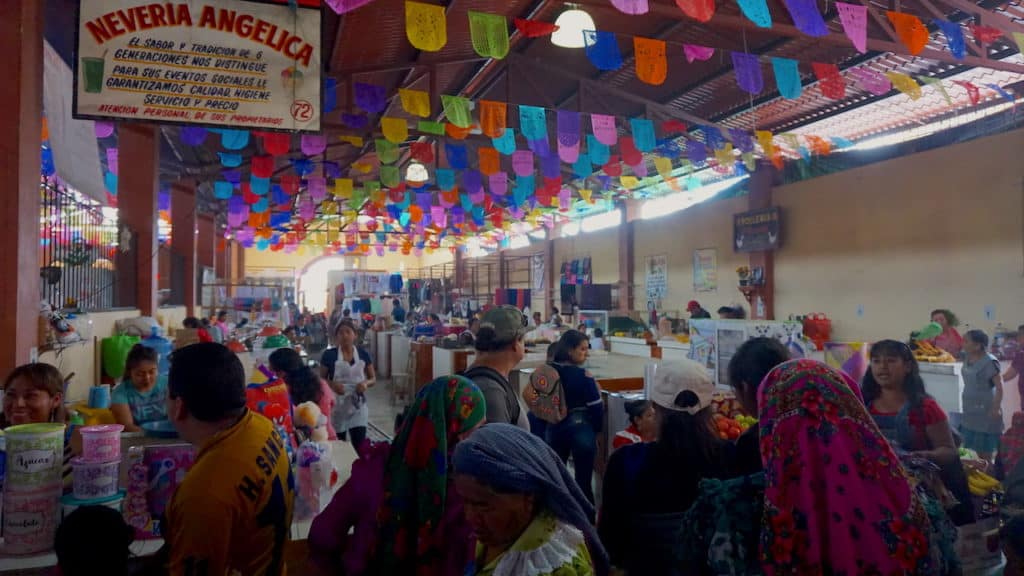
16. Tlacolula Market (Sunday)
The most well-known Sunday market in Oaxaca amongst tourists, the Mercado de Tlacolula is a must-visit. This busy Oaxaca Sunday market takes place in the town of Tlacoula de Matamoros, about a 45-minute drive east of the city.
Also called the Tianguis de Tlacolula, a Sunday visit to the Tlacolula Market in Oaxaca is one of the top things to do in the area.
The Tlacolula Sunday Market is the second-largest market in the state of Oaxaca. It’s an authentic market that has played a major role in local trade and commerce since centuries ago.
Wander the maze of vendors selling everything from mezcal to handwoven baskets, while you take in all of the new sights, sounds, and smells.
Don’t miss the town’s trademark spiral bread, pan de cazuela, filled with cinnamon, raisins, and Oaxacan chocolate. Stop by Doña Adolfa for a bowl of the famous Tlacolula barbacoa, tender slow-cooked goat meat stew. The brothy barbacoa is topped with cabbage, radishes, and lime juice and served with fresh tortillas.
Tlacolula is on the same road to the Mitla archeological ruins, so you can stop by multiple spots (like mezcal tasting in Matatlan) on that same trip.
To get to Tlacolula Market from Oaxaca, you can rent a car, take a taxi, or hop on a colectivo or bus heading toward Mitla.
🌶 This Sunday tour to Tlacolula Market includes a visit to the nearby Yagul ruins, the artisan town of San Jeronimo Tlacochahuaya, and the traditional Sunday market in Tlacolula.T
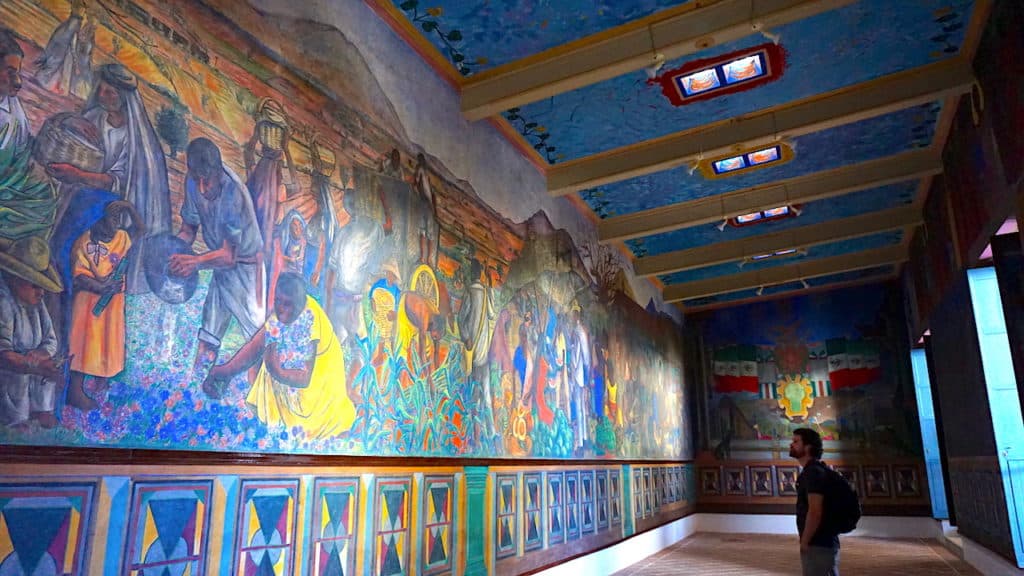
17. Ocotlan Market (Friday)
Located about an hour’s drive south of Oaxaca City, Ocotlán de Morelos is home to the Ocotlan Market on Fridays.
This village market day is known for catering more to farmers, due to its metal work, farming tools, and livestock sales. Rows of machetes, hammers, stakes, plows, and other useful farming equipment line the streets; some are built for utilitarian purposes and others with complex designs suitable for family heirlooms. Large stalls with amazing leatherwork caught our attention as well, including horse saddles, whips, and leather bags of all sizes.
We prefer the Ocotlan market over the Tlacolula market because we like the town itself more and it’s less hectic.
When visiting the Ocotlán market, take the opportunity to wander this charming town’s peaceful plaza, see its impressive church, and admire the colorful murals by local artist, Rodolfo Morales.
You can also stop by the artisan handicraft villages of Jalieza and Tilcajete on the way down to Ocotlan.
18. Teotitlán del Valle Market (Monday)
Known as the weaving town, Teotitlan del Valle hosts its official Teotitlan Market on Mondays, but you can visit the market any day of the week.
The village of Teotitlán del Valle is home to an artisan community that produces colorful and intricate wool rugs. Here, you can witness the traditional art of rug weaving that has been passed down through generations.
Wander the town, explore the workshops, and marvel at the waist looms where skilled artisans create stunning textiles using natural dyes and traditional Zapotec designs.
19. Villa de Etla Market (Wednesday)
If you’re a cheese lover, head straight to Villa de Etla on a Wednesday. This unassuming town is the birthplace of the world-famous Oaxaca cheese, locally known as quesillo.
While you can visit the Etla Market any day of the week, Wednesday is when the streets fill up with vendors in true tianguis fashion.
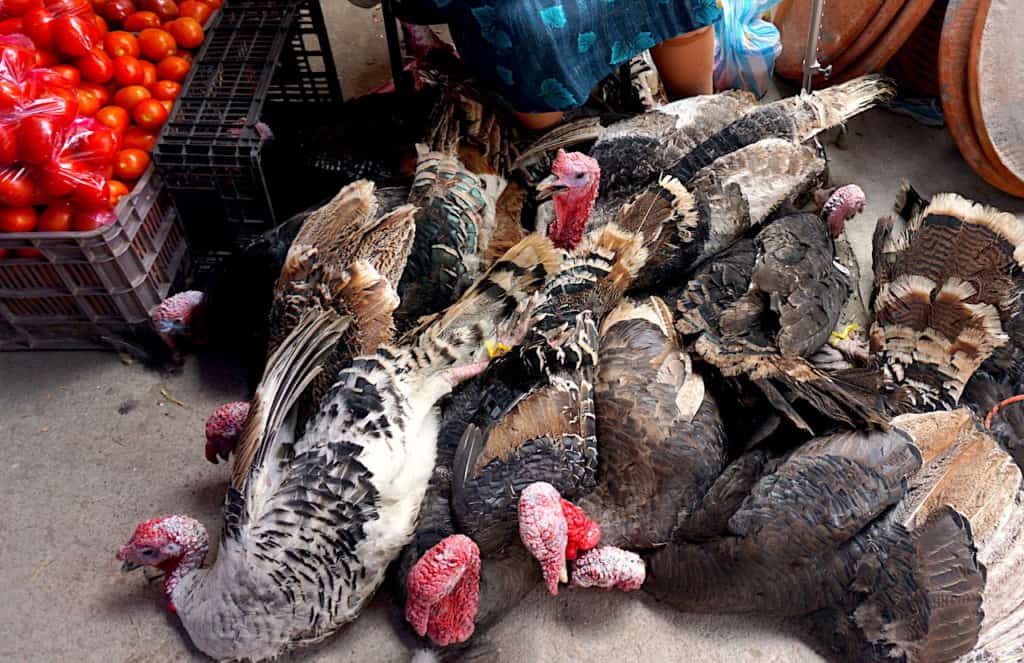
20. Zaachila Market (Thursday)
The Zaachila Market on Thursdays is considered one of the most traditional village market days. Villa de Zaachila is located only 9 miles south of Oaxaca City.
The Zaachila Market is held entirely outside with some vendors setting up their goods on blankets on the ground. One of the highlights of this ancient market is its livestock area.
To get off the tourist track, visit the Zaachila Market on its dia de plaza.
Food Prices at the Markets in Oaxaca
Overall, the prices at the markets in Oaxaca are very affordable and much cheaper than those around the main square. The Zócalo is one of the main tourist attractions in the area, and as such, has some of the most expensive and underwhelming food in town.
Foodies wanting to savor authentic Oaxacan flavors on a budget should head straight to Mercado 20 de Noviembre or any other market on this list. You’ll find a steep drop in prices and much more flavorful food than the Zocalo.
You can have an entire meal at a comedor in Mercado 20 de Noviembre for 80 to 150 pesos, buy a torta for less than 30 pesos, sip on freshly-made juice for less than 40 pesos, and have a pan dulce for dessert for less than 10 pesos. Beer and mezcal prices can fluctuate wildly, anywhere from 30 to 90 pesos.
If the prices aren’t on the menu, don’t be afraid to ask how much things are before you order. It isn’t uncommon for places without published prices to charge tourists a bit more, but it always helps to let them know you’re aware of how much things should be. This also helps to verify the total bill is accurate because receipts are rarely handed out at small food stalls.
And finally, one last tip about your money while eating at the markets. Check your change and don’t accept any bills that have been ripped and taped together. Other places will not accept those for payment.
But don’t let that keep you away! If you see that they didn’t give you enough change, tell them it’s wrong (está mal), and they will correct it immediately in most cases.
➡️ Check out How to Use Money in Mexico for more helpful money tips.
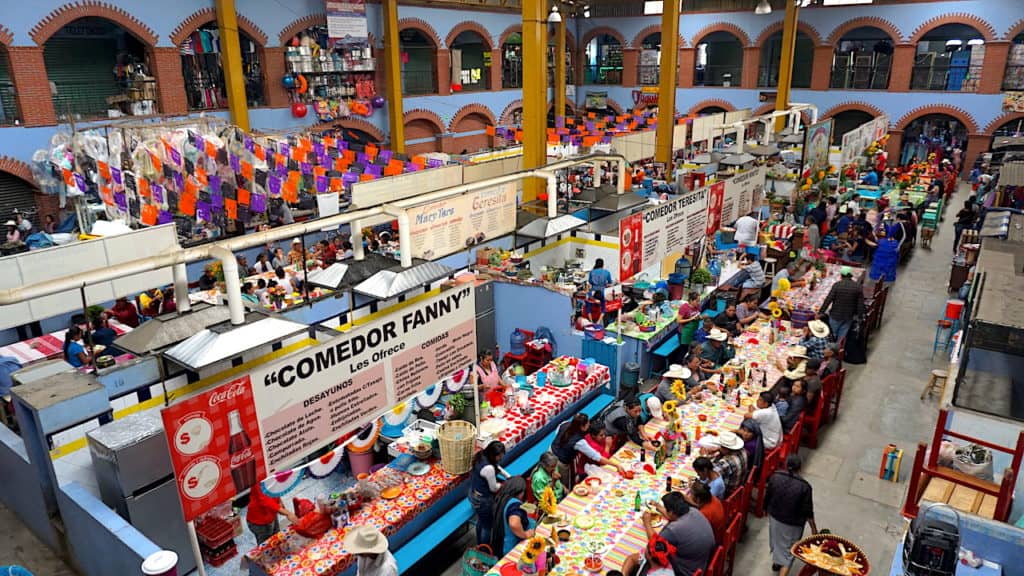
What to Pack for the Markets
Here are a few essentials we recommend bringing with you when you venture into the markets in Oaxaca.
- Cash and change: Bring enough Mexican pesos in cash to cover your purchases. Cash is king at the markets and cards are not accepted. It’s best to carry small bills and coins in case they don’t have change.
- Anti-theft bag: Using a theft-proof purse or backpack helps prevent pickpocketing and bag-slashing. I have a small anti-theft purse like this crossbody anti-theft purse.
- Reusable tote bag: Plastic bags are banned in many parts of Mexico, like Oaxaca City. Bring a reusable tote bag for carrying your purchases.
- Hand sanitizer and tissues: Carry a little Mexican bathroom kit with hand sanitizer and tissues. This way you don’t run into any issues if there’s no toilet paper or soap.
- Google Translate app: This translation app can work wonders when trying to communicate in another language. We’re covering Spanish phrases for markets below, but downloading this app also helps.
Spanish Phrases to Know
Prepare for your trip and improve your Spanish skills with this free Spanish travel phrases sheet.
Unlike some of the other Spanish phrase lists floating around the internet, this one is actually written by a native Mexican Spanish speaker…me! This means you’re not going to accidentally insult someone or cause confusion by using phrases from other Spanish-speaking countries.
Commonly used words and phrases for markets in Spanish:
- Hola — Hello
- Por favor — Please
- Gracias — Thank you
- ¿No hablo español. Habla inglés? — I don’t speak Spanish. Do you speak English?
- ¿Dónde esta…? — Where is…?
- ¿Cuánto cuesta? — How much does it cost?
- ¿De qué material está hecho? — What material is this made from?
- Quisiera — I want…
- Mercado — Market
- Tianguis — flea market
- Artesanías — handicrafts
- Comedor or fonda — Food stall or eatery
- Comida — food
- Bebidas — beverages
- Botella de mezcal — bottle of mezcal
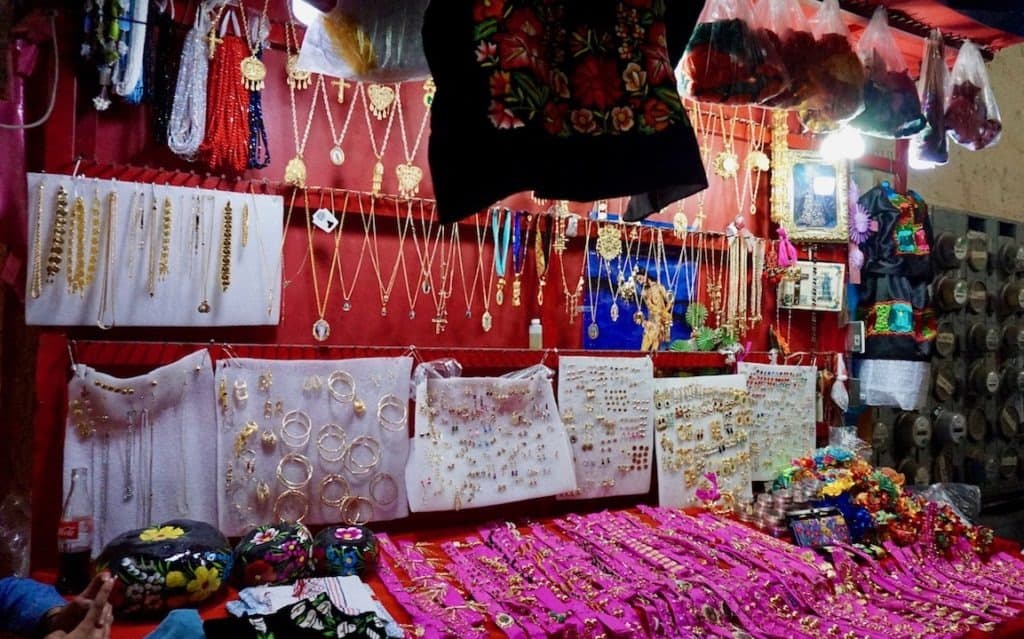
Oaxaca Markets FAQ
These are a few of the most commonly asked questions about the Oaxaca City markets.
What is the most famous market in Oaxaca?
The most famous markets in Oaxaca are Mercado Benito Juarez and Mercado 20 de Noviembre. These are both large markets situated just a few blocks south of the main square, El Zocalo. They are a top tourist attraction in Oaxaca and a common stop on guided tours.
🌮 Book this Authentic Street Food and Oaxaca City Markets Tour for a guided exploration of Oaxaca’s most famous markets and traditional dishes.
What is Oaxaca most famous for?
Oaxaca is most famous for its cultural heritage, culinary delights, artisanal crafts, indigenous communities, and joyful festivals.
It is renowned for its diverse and flavorful cuisine, including iconic dishes like mole and tlayudas. The region is known for producing exquisite artisanal crafts such as textiles woven on waist looms, pottery made with different colors of clay, and intricate wood carvings known as alebrijes.
Oaxaca’s festivals, including the Day of the Dead in November and the Guelaguetza in July, showcase its ancient traditions and cultural celebrations.
➡️ Check out this Complete Guide to Oaxaca to learn more about this enchanting destination.
Are the markets in Oaxaca safe?
The markets in Oaxaca are generally safe for tourists. But you should still take precautions, just as you would in any busy public space. Keep an eye on your belongings, especially in crowded areas, and be aware of your surroundings.
It’s also recommended to stick to well-lit and busy areas if you’re visiting in the evening. Traveling in a group or with a guide can provide an extra layer of security and help navigate the markets effectively.
➡️ Check out our top safety tips for Mexico for more advice.
How do I negotiate prices at the markets in Oaxaca?
Negotiating prices at the markets in Oaxaca is a common practice when purchasing certain products, but not at eateries.
Start by showing interest in the product and engaging in friendly conversation with the vendor. Politely ask for the price and then offer a lower price, keeping in mind that the vendor may counter with a higher amount.
Be prepared to negotiate and find a mutually agreeable price. It’s important to be respectful throughout the process.
➡️ Read our guide to Using Money in Mexico for more money-saving tips for your trip.
Are vegetarian and vegan options available at food stalls?
Yes, vegetarian and vegan options are available at the food stalls in Oaxaca. Oaxacan cuisine offers a variety of plant-based dishes that highlight local ingredients such as beans, corn, squash, squash blossoms, and cactus.
You can enjoy vegetarian and vegan empanadas, tlayudas, memelas, enfrijoladas (tortillas with bean sauce), spicy salsas, and tasty guacamole. Many food stalls also offer fresh fruit, salads, sandwiches, and refreshing aguas frescas.
➡️ Read our Guide to Eating Vegetarian and Vegan in Mexico for more insider tips and must-read info on how to order.
Final Thoughts: Best Markets in Oaxaca City
Exploring the markets of Oaxaca City is an invitation to discover the essence of this captivating and unique destination.
Immerse yourself in the vibrant atmosphere, indulge in delectable cuisine, and bring home handmade treasures that embody the spirit of Oaxaca.
Even if you only have a short stay in Oaxaca, or if you’re visiting for Oaxaca Day of the Dead, make sure to take a couple of hours and go for a stroll through the markets.
The three markets closest to the main plaza are Mercado Benito Juárez, Mercado 20 de Noviembre, and Mercado de Artesanías. Depending on your taste, finding the right food, drinks, knick-knacks, or textiles is just a matter of walking a few minutes south of Zocalo.
Stop to enjoy a tlayuda and michelada, or a hot chocolate with some pan de yema. Your belly, and even your wallet, will thank you.
The Oaxaca markets await, ready to captivate and inspire you!
Best Oaxaca Market Tours:
- 🌮 Best Food & Markets Tour: Eat Like a Local Oaxaca Food Tour
- 🧑🍳 Best Cooking Class & Market Tour: Oaxacan Cooking Class and Market Visit
- 🌶 Best Village Market Day Tour: Tlacolula Sunday Market with Local Guide
Which Oaxaca markets are at the top of your itinerary? Let us know in the comments below.
Like This Post? Pin It!
